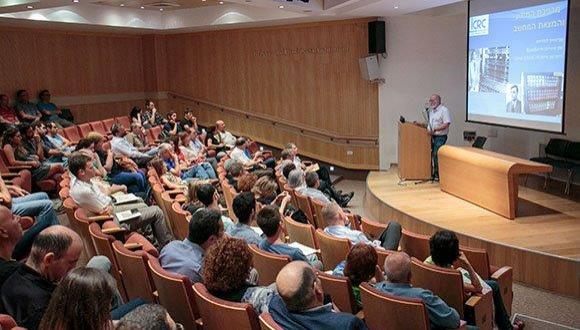סמינר מחלקתי ביה"ס להנדסה מכאנית Ben vais and Limor Burshtein
SCHOOL OF MECHANICAL ENGINEERING SEMINAR Wednesday, march 15, 2017 at 14:00 Wolfson Building of Mechanical Engineering, Room 206
Incorporating micro-mechanical model into FEM for predicting fatigue failure of a unidirectional composite structure Limor BurshteinMSc Student of Prof. Rami Haj-Ali
This study presents a generic fatigue model of laminated composite materials and structures. The model incorporates a method for predicting fatigue failure of unidirectional laminate under multiaxial tension-tension loading into a multi-scale framework for the fatigue analysis of composite structures. Towards that goal, the unidirectional fatigue model is implemented in the Abaqus finite-element (FE) software. The simplified micromechanical method of cells (MOC) model is used within the fatigue framework to represent stress field inside the RUC for each of the layers in the shell elements. The analysis involves the examination of the local stresses, in the fiber and the matrix regions, induced by the applied external loading. Explicit matrix and fiber failure criteria are used to determine these failure modes and perform elastic degradation beyond this level for fatigue progressive analysis. The fiber and matrix fatigue failure functions are calibrated using data extracted from three S-N experimental curves under uniaxial tension, transverse tension and axial shear loading modes.
The Abaqus FE shell elements model are linked to UMAT subroutine which describes the material elastic properties during the loading cycles. In this subroutine material property are updated with correspondence to fatigue failure criteria in each constituent.
The layered fatigue framework is shown to be capable of predicting the S-N fatigue life for different laminated coupons under tension-tension loading. In addition, the proposed fatigue framework is applied for the fatigue analysis of a laminated plate with an open hole. This work can be extended for future application of damage tolerance.
School of Mechanical Engineering Seminar
Wednesday, March 15, 2017 at 14:00
Wolfson Building of Mechanical Engineering, Room 206
CONTROLLING TORQUED ORTHOTROPIC METALLIC NANOPARTICLES IN AN ELECTROLYTE BY MEANS OF AC ELECTRIC FORCING
Ben Weis Goldstein
MSc. Student of Professor Touvia Miloh
A theoretical study is provided for determining the angular velocity of an ideally polarized (metallic) nano-particle freely suspended in a symmetric electrolyte under ambient AC electric field excitations. First, we discuss electro-rotation (ROT) and electro-orientation (EOR) of nano-particles, of prolate spheroid shape, excited by two orthogonal electric field components which may be in or out of phase. The analytic expressions obtained are valid for a conducting prolate spheroid with arbitrary eccentricity including the limiting cases of isotropic spheres and slender rods. The total dipolophoretic (DIP) angular velocity is decomposed from contributions due to dielectrophoresis (DEP) induced by the dipole-moment within the particle and by the induced-charge electrophoresis (ICEP) caused by the Coulomb force density within the Debye layer in the solute surrounding the conducting particle. Some comparisons with available known solutions and experimental data are also provided. In the second part, we present a novel theoretical study of 3D electro-rotation of ideally polarizable nano orthotropic particles. Comparisons to known solutions of sphere and prolate spheroid are presented and a new solution for oblate spheroid is derived, which could be reduced to the case of a ‘flat disk’. Furthermore, two specific 3D excitation problems are presented, showing the potential in controlling both velocity and direction using 3D forcing.


